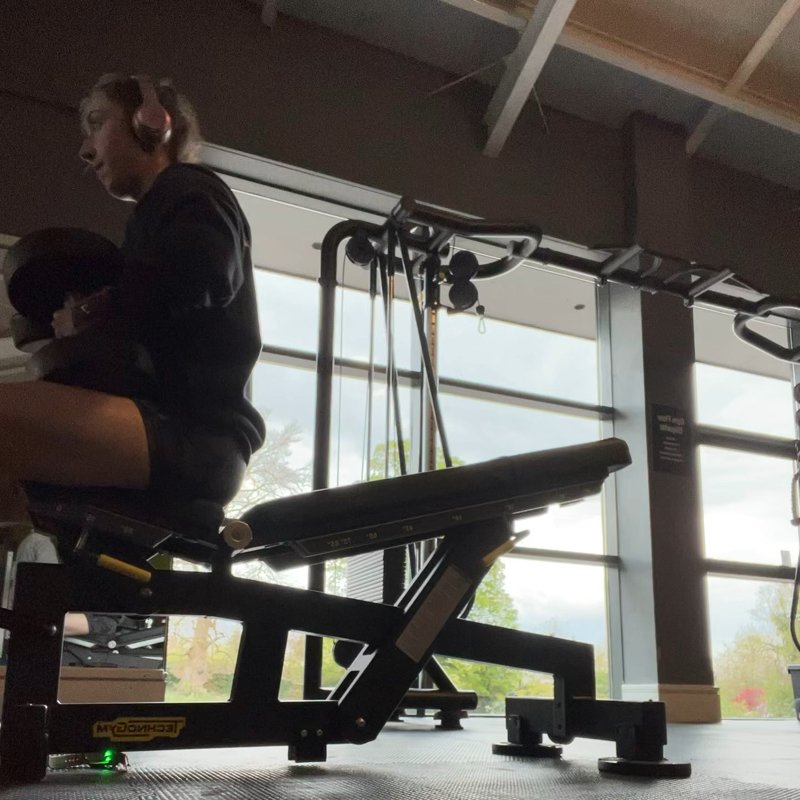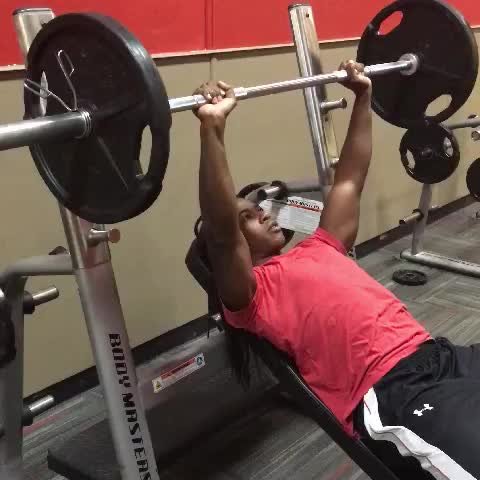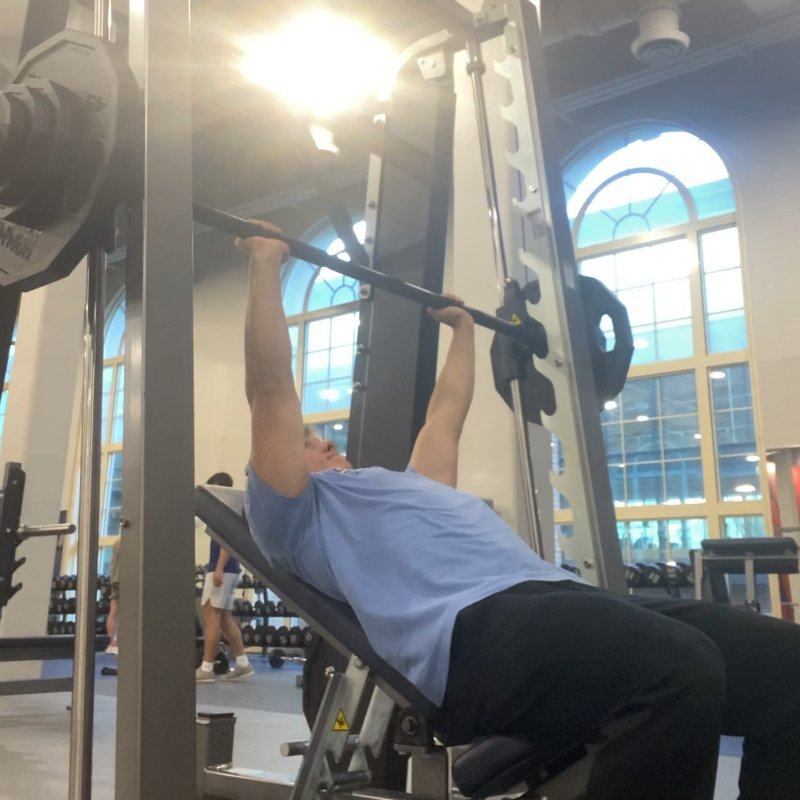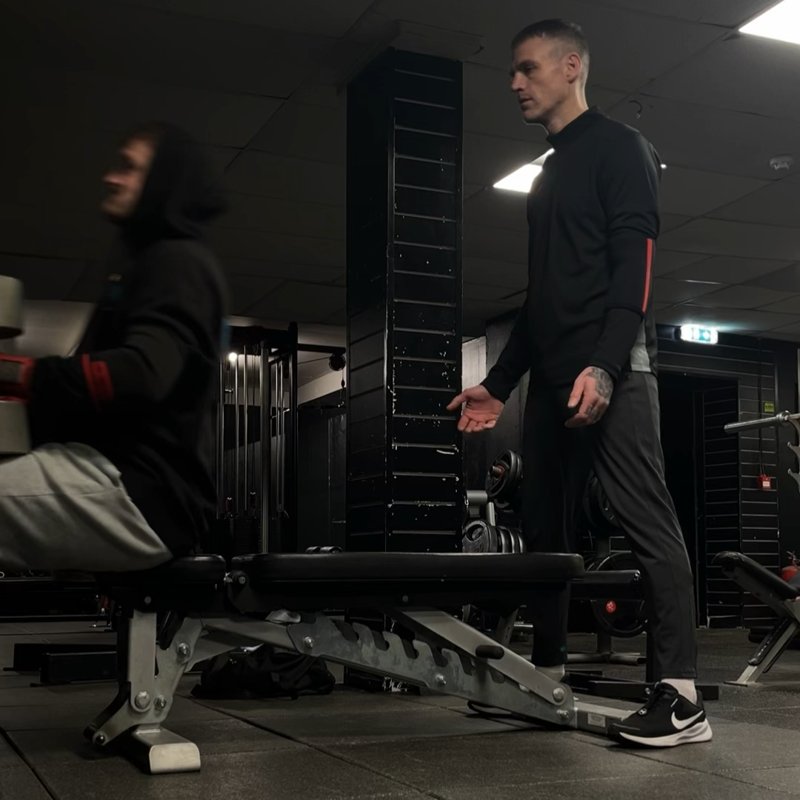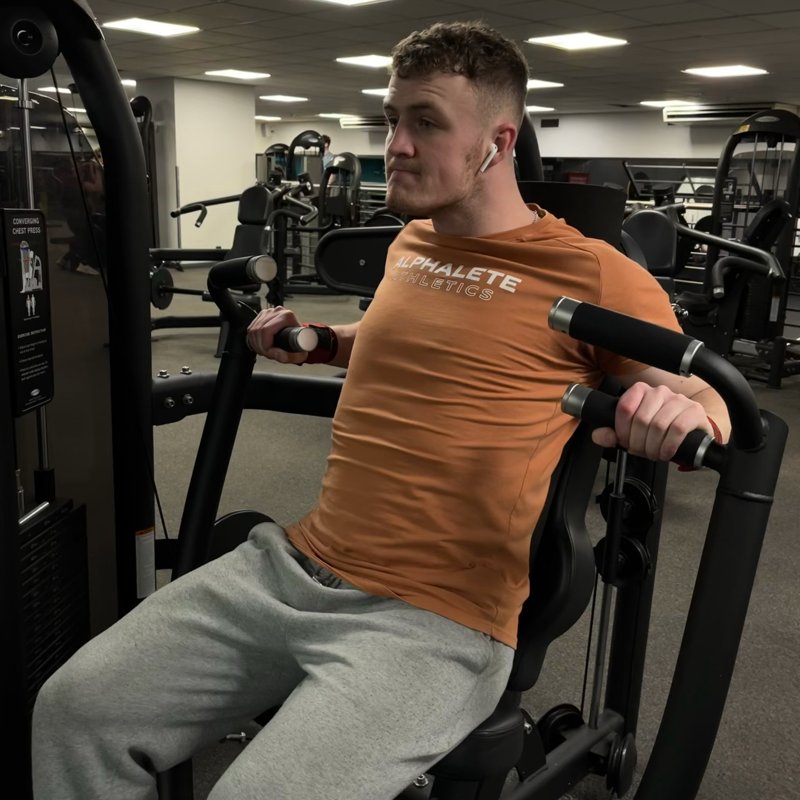Incline Chest Press: The Ultimate Guide
The Incline Machine Chest Press is a compound pushing exercise performed on a specialized machine that targets the upper chest, anterior deltoids, and triceps through a guided pressing motion at an inclined angle.

Quick Facts
Key Benefit
Targeted upper chest development with consistent resistance
Primary Muscles
Anterior Deltoids, Pectoralis Major, Triceps
Secondary Muscles
Abdominals, Medial Deltoids, Pectoralis Minor
Equipment
machine
Difficulty
Beginner
Type
Strength
In This Guide
Ready to master the Incline Chest Press?
Track your progress, see improvements over time, and build strength consistently.
Download GravitusThe Incline Machine Chest Press stands as one of the most effective exercises for developing the upper portion of the pectoralis major—the fan-shaped chest muscle that contributes significantly to upper body aesthetics and pushing strength. By utilizing a fixed pressing path at an inclined angle, this exercise specifically targets the clavicular head of the chest while engaging the anterior deltoids and triceps as important synergists.
What makes the machine variation particularly valuable is its guided movement pattern. The fixed trajectory eliminates many of the stabilization and balance requirements present in free weight variations, allowing users to focus exclusively on the pressing movement and potentially use heavier loads or perform higher repetitions with reduced injury risk. This makes it especially beneficial for beginners learning proper pressing mechanics, those rehabilitating from certain injuries, or experienced lifters seeking to maximize chest stimulation with minimized joint stress.
Beyond aesthetic benefits, strengthening the upper chest region contributes to improved shoulder stability, enhanced performance in all pressing movements, and more balanced overall chest development. The upper portion of the chest often requires specific emphasis, as standard flat pressing exercises may not provide sufficient stimulus for complete pectoral development.
Whether you're looking to build a more balanced and aesthetically pleasing chest, improve functional pushing strength, or add another effective tool to your pressing arsenal, the Incline Machine Chest Press offers an accessible and effective approach to upper body development.
Benefits of Incline Machine Chest Press
The Incline Machine Chest Press offers several unique advantages that make it a valuable addition to any upper body training program.
Upper Chest Emphasis
The inclined angle specifically targets the clavicular (upper) head of the pectoralis major, which is often underdeveloped relative to the sternal portion.
Guided Movement Path
The fixed trajectory ensures proper form and reduces the stabilization demands present in free weight variations, potentially allowing for heavier loading.
Joint-Friendly Loading
Many machines feature designs that create natural movement arcs and reduce stress on the shoulder and elbow joints compared to some free weight exercises.
Isolation with Safety
Enables focused chest development without the risks associated with heavy free weight training, such as failed repetitions or the need for spotters.
Consistent Resistance
Most machines maintain continuous tension throughout the range of motion, maximizing time under tension for muscle development.
Proper Form & Technique
Setup
- Adjust the seat height so that the machine's handles or press arms align with your mid-chest level.
- If the machine has an adjustable back angle, ensure it's set to an appropriate incline (typically 30-45 degrees).
- Sit with your back firmly against the back pad, maintaining contact throughout the movement.
- Place your feet flat on the floor or on any provided foot platforms for stability.
- Grasp the handles with a comfortable grip—typically slightly wider than shoulder-width.
- Position your elbows at approximately a 90-degree angle in the starting position, neither too far forward nor back.
- Draw your shoulder blades slightly back and down to create a stable foundation for pressing.
- Engage your core to stabilize your torso and maintain proper posture throughout the exercise.
- Adjust the weight selector pin to an appropriate resistance for your strength level.
Movement
- Push the handles or press arms forward by extending your elbows and contracting your chest muscles.
- Maintain consistent pressure through both hands, avoiding one-sided pressing.
- Continue the pressing motion until your arms are extended but not completely locked out.
- At the end of the movement, focus on squeezing your chest muscles briefly for maximum contraction.
- Slowly control the return to the starting position, allowing your chest muscles to stretch slightly.
- Maintain constant tension throughout—don't allow the weight stack to touch down between repetitions.
- Keep your head, upper back, and glutes in contact with the seat pads throughout the movement.
- Maintain consistent breathing—typically exhaling during the pushing phase and inhaling during the return.
- Repeat for the desired number of repetitions, focusing on quality movement rather than momentum.
Key Form Tips
Chest Engagement
Focus on pushing primarily with your chest muscles rather than your shoulders or triceps, maintaining awareness of pectoral contraction throughout.
Range of Motion
Find a range that allows maximum chest contraction without causing shoulder discomfort, avoiding excessive stretching at the bottom or complete lockout at the top.
Elbow Position
Keep your elbows at a moderate angle relative to your torso—not flared excessively wide nor tucked extremely close—to balance chest activation with joint comfort.
Shoulder Position
Maintain your shoulders down and back throughout the movement, avoiding the tendency to roll them forward at the end of the repetition.
Controlled Tempo
Resist using momentum, particularly on the return phase, to maximize tension on the chest muscles and reduce joint stress.
Muscles Worked
Primary Muscles
- pectoralis major: The chest muscle, primarily the upper portion attached to the clavicle which is the main target of this exercise due to the inclined angle. The larger, lower portion of the chest muscle also receives secondary activation during the incline press.
- anterior deltoids: The front portion of the shoulder muscle that assists significantly in pressing movements, especially at inclined angles.
- triceps: The three-headed muscle on the back of the arm responsible for elbow extension during the pressing movement.
Secondary Muscles
- Pectoralis Minor: A small muscle that lies beneath the pectoralis major and assists with scapular movement during pressing. Also includes the finger-like muscles along the ribs that help stabilize the shoulder blade during pressing movements.
- medial deltoids: The middle portion of the shoulder muscle that provides minor assistance and stabilization during the movement.
- abdominals: Engage isometrically to maintain proper posture and stability throughout the exercise.
Common Mistakes and How to Fix Them
Excessive Weight
Using too much resistance, leading to compromised form, reduced chest activation, and potential shoulder strain. Select a weight that allows for proper form throughout the entire set while still providing sufficient challenge. Focus on feeling your chest muscles working throughout the movement rather than simply moving the weight. Consider temporarily reducing the weight to establish proper form and mind-muscle connection before progressing to heavier loads. Remember that effective chest development comes from quality contractions rather than simply moving maximum weight, especially on machine exercises where stabilization demands are reduced.
Insufficient Range of Motion
Not allowing adequate stretch at the bottom or contraction at the top, limiting muscle development and exercise effectiveness. Lower the weight until you feel a comfortable stretch in your chest muscles without excessive shoulder strain. Press to near full extension without completely locking out the elbows, which maintains tension on the chest. If range of motion is limited by discomfort, check that the machine is properly adjusted for your body proportions. Consider that appropriate range may vary between individuals based on shoulder structure and mobility—focus on the range that provides maximum chest activation with minimum joint stress for your specific situation.
Arching the Lower Back
Excessively arching the lower back during the pressing movement, which can reduce chest engagement and potentially create lower back stress. Maintain contact between your back and the back pad throughout the entire movement. Engage your core muscles before initiating the press to stabilize your torso position. Avoid the tendency to push the chest forward excessively at the bottom position. If lower back arching persists, consider checking your foot position and potentially bringing your feet closer to the machine to encourage a more neutral spine position.
Shoulder Elevation
Allowing the shoulders to rise toward the ears, particularly during the pressing phase, which can reduce chest activation and increase upper trapezius involvement. Focus on keeping your shoulders drawn down and back throughout the entire movement. Think about "packing" your shoulder blades down and together before initiating each repetition. Imagine pressing from a foundation of stable shoulder blades rather than allowing them to elevate. If shoulder elevation persists, consider temporarily reducing the weight until proper positioning becomes more habitual.
Uneven Pressing
Pushing harder with one side than the other, potentially reinforcing or creating muscle imbalances over time. Focus on applying equal force through both hands throughout the entire movement. Occasionally perform unilateral (single-arm) variations if the machine allows, to identify and address strength discrepancies. Consider using visual feedback from a mirror if available to monitor symmetrical movement. If persistent imbalance occurs, consult with a qualified trainer to assess potential mobility or structural issues that might be contributing to the asymmetry.
Incline Machine Chest Press Variations
Machine Design Variations
-

Plate-Loaded Incline Press Machine
Uses weight plates rather than a weight stack, typically allowing for more precise loading increments and often a more natural movement arc.
-

Converging Incline Press Machine
Features a movement path that brings the hands closer together at the top of the motion, potentially increasing peak contraction in the chest.
-

Iso-Lateral Incline Press Machine
Allows each arm to move independently, helping to identify and address potential strength imbalances between sides.
-
Cable Incline Press
While not strictly a machine, many cable stations can be configured for incline pressing movements that provide constant tension throughout the range of motion.
Technical Variations
-

Single-Arm Incline Machine Press
Performing the movement one arm at a time, which increases core stabilization demands and allows focused work on potential imbalances.
-

Partial Range Incline Machine Press
Deliberately using a shorter range of motion, typically at the challenging mid-range or peak contraction portion of the movement.
-

Tempo Incline Machine Press
Manipulating the speed of different phases (e.g., 3 seconds eccentric, 1 second pause, 2 seconds concentric) to increase time under tension.
-

Drop Set Incline Machine Press
Performing a set to near-failure, then immediately reducing the weight and continuing for additional repetitions without rest.
Frequently Asked Questions
The incline machine chest press, incline barbell press, and incline dumbbell press all effectively target the upper chest, but they offer distinct advantages that can make them complementary rather than competing exercises in a comprehensive chest training program.
The incline machine press provides several benefits: The guided movement path reduces stabilization demands, allowing greater focus on the target muscles. Machine designs often create ergonomic pressing paths that can reduce joint stress for some individuals. The fixed trajectory and stable support minimize technical requirements, potentially enabling higher volume or heavier loading with reduced injury risk. Most machines feature weight stacks that allow for quick, precise loading adjustments without the need for plate changes or spotters.
The incline barbell press maintains its own unique advantages: It engages more stabilizer muscles due to the free weight nature, potentially creating greater overall strength development. The bilateral fixed grip can allow for heavier absolute loading than other variations. It develops more transferable strength for other pressing movements and functional activities. The barbell creates a fixed hand position that maintains consistent relative loading throughout the set.
The incline dumbbell press offers additional benefits: Independent movement of each arm can address or prevent strength imbalances between sides. The free motion allows the arms to find their most natural path based on individual shoulder structure. The unstable nature of dumbbells creates greater stabilization demands, potentially activating more supporting musculature. The movement typically allows for greater range of motion, especially at the bottom stretch position.
From a practical application standpoint: The machine variation might be preferred for beginners learning proper pressing patterns, those rehabilitating from certain injuries, or when training without a spotter. The barbell variation might be favored for maximum strength development and systematic progression tracking. The dumbbell variation might be optimal for those prioritizing muscle balance, joint-friendly pressing paths, or maximum range of motion.
The ideal approach for most trainees is to incorporate multiple variations in their training program, either across different training cycles or within a comprehensive chest routine that utilizes the unique benefits of each implement.
The optimal incline angle for chest pressing balances maximum upper chest (clavicular head of the pectoralis major) activation while minimizing excessive anterior deltoid involvement. While individual factors influence the ideal angle, research and practical experience provide some general guidelines.
Most evidence suggests that an incline between 30-45 degrees provides the best balance for most individuals: Angles lower than 30 degrees begin to shift emphasis toward the sternal (middle/lower) head of the pectoralis major. Angles higher than 45 degrees tend to increase anterior deltoid involvement while potentially reducing upper chest activation.
Many commercial incline machines are fixed at approximately 30-45 degrees, which manufacturers have determined to be optimal for the majority of users. Some advanced machines offer adjustable angles, allowing for more personalized positioning.
Individual factors that might influence your ideal incline angle include: Your specific chest development goals and current muscular balance. Individual chest anatomy and fiber distribution patterns. Previous shoulder injuries or mobility limitations. The specific machine design and how it positions your body relative to the pressing path.
If your machine allows angle adjustment, consider this practical approach: Start with a moderate 30-degree incline and perform a set with focused attention on where you feel the work. Adjust the angle slightly up or down for subsequent sets, noting changes in muscle activation and comfort. Identify the angle that creates maximum upper chest engagement with minimum shoulder discomfort for your individual structure.
Remember that variety can be beneficial—occasionally varying the angle within the general 30-45 degree range can potentially stimulate different portions of the upper chest and prevent adaptation plateaus. However, for most trainees, finding a consistent, effective angle and focusing on progression with that setup will yield the best long-term results.
The appropriate weight for incline machine chest press depends on your training experience, current strength level, specific goals, and most importantly, your ability to maintain proper form throughout the movement.
As a general guideline, select a weight that allows you to complete your target repetitions with proper form while still finding the last few reps challenging. This creates sufficient stimulus for adaptation without compromising technique or safety.
Different training goals suggest different loading strategies: For strength development, working in the 6-8 repetition range with heavier weights might be appropriate. For hypertrophy (muscle growth), the 8-12 repetition range with moderate weights often provides optimal stimulus. For muscular endurance or beginners learning the movement, 12-15+ repetitions with lighter weights can be beneficial.
The key indicators that your weight selection is appropriate include: You can maintain proper shoulder and back positioning throughout the set. You achieve a full range of motion without compensatory patterns. You feel primary fatigue in your chest rather than shoulders or triceps dominating. You can control the weight with proper tempo throughout the entire range of motion.
For optimal development, implement a progressive approach: Begin with a weight that allows perfect execution while learning the movement pattern. Gradually increase resistance in small increments when you can consistently perform all planned repetitions with excellent form. When progress stalls, consider manipulating other variables (rest periods, tempo, frequency) before simply adding more weight.
Remember that with machine exercises where stabilization demands are reduced, the focus should be on quality muscle contraction rather than simply moving maximum weight. Many successful trainees find that moderate weights with perfect execution produce better results than heavier weights with compromised form, particularly for chest development where mind-muscle connection significantly impacts results.
Feeling the incline chest press primarily in your shoulders rather than your chest is a common issue that typically stems from a combination of technique, muscle activation patterns, and potentially the specific machine design. Several adjustments can help shift emphasis toward the intended target muscles.
First, consider these technique modifications: Slightly retract and depress your shoulder blades before initiating the movement, creating a more stable foundation for chest activation. Focus on pushing through the heel of your hand rather than primarily through the fingers or palm, which can help engage the chest more effectively. Experiment with a slightly wider grip if the machine allows, as narrower grips tend to increase triceps and anterior deltoid involvement. Ensure you're not lifting your shoulders toward your ears during the pressing motion, which shifts emphasis away from the chest. Concentrate on feeling your chest muscles contract throughout the movement, using mental focus to enhance the mind-muscle connection.
Several machine setup factors can also influence muscle recruitment: Check that the seat height positions your chest appropriately relative to the handles or press arms. If the angle is adjustable, try reducing it slightly (e.g., from 45 to 30 degrees) to decrease shoulder involvement. Ensure the range of motion is appropriate—excessive stretching at the bottom can shift emphasis toward the shoulders.
Before your pressing movements, consider implementing activation techniques: Perform specific chest activation exercises like cable flyes or push-ups with a conscious chest focus before moving to the incline press. Use tactile feedback by placing your non-working hand on your upper chest during unilateral (single-arm) presses to enhance awareness. Consider a brief pre-exhaust technique with an isolation movement to activate the chest before pressing.
If these adjustments don't resolve the issue, examine your overall program design: Ensure you're not overtraining the anterior deltoids through excessive overhead or incline pressing volume. Consider temporarily reducing the weight to focus exclusively on technique and muscle activation. Evaluate whether your chest muscles might be disproportionately weak compared to your shoulders, potentially requiring more foundational chest development work.
Remember that some anterior deltoid involvement is normal and expected with incline pressing movements, but the chest should still feel like the primary working muscle for optimal development.
Track your progress with Gravitus
Download Gravitus to log your workouts, track your progress, and join a community of fitness enthusiasts.

Helpful Resources
One Rep Max Calculator
Find your one rep max for any exercise without maximal testing. Essential for developing effective strength training programs.
Calculate 1RMWorkout Programs
Follow structured workout programs created by fitness professionals to maximize your strength and muscle gains.
View Programs